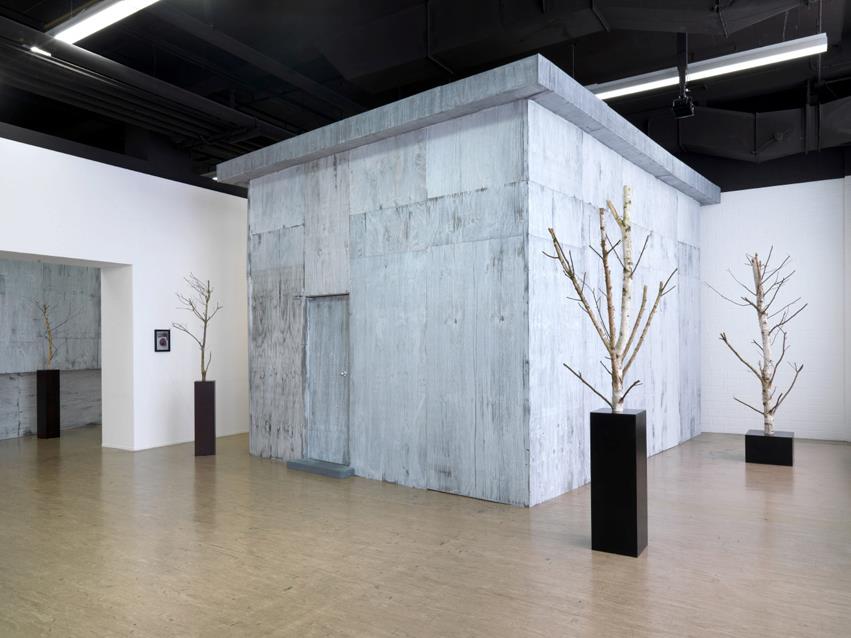Thomas Zipp
27 Apr - 28 Jul 2012
For Gallery Weekend Berlin 2012, Galerie Guido W. Baudach is pleased to present a new exhibition of work by Thomas Zipp at both its locations in Wedding and Charlottenburg.
In BLACKOUT CHAMBERS, L ́ARC DE CERCLE & DISSOCIATIVE AMNESIA, Zipp brings together individual works of sculpture, painting and graphic art into a complex, comprehensive spatial installation, its overall appearance evoking associations of a village settlement. The ramified ensemble is dominated by five large-scale sculptures, four at the gallery in Wedding and one in Charlottenburg. With their pregnant overhanging roofs and rustic wooden facades, the external form of these walk-in works recalls the architecture of the hut. The sense of being on rural terrain is reinforced by tree sculptures on pedestals which are distributed throughout the exhibition as though they were isolated inhabitants. But the wooden huts contain more than their pseudo-weathered surfaces would seem to suggest. Whilst an appropriate panelling prevails on the spartan interiors, in the case of the hut presented at the Charlottenburg section of the exhibition, for instance, the panelling is painted a glistening white. From the ceiling hangs a forlorn swing. By contrast, the partially furnished interiors of the large-scale sculptures in Wedding are completely mirrored. Multiple reflections call up a feeling of disorientation and a sense of hovering. Looking down at the floor, the viewer sees himself from above – an optical effect that simultaneously makes perceptible the state of being detached from one’s own body. Not for nothing does the title of the exhibition include the psychological concept of dissociation, for this term describes a specific dysfunction, a rupture in selfperception or the capacity for integral consciousness. It refers to a subject which is intrinsic to the show as a whole: a confrontation with the phenomenon of the dissolution of individuality and identity.
Numerous large-format paintings with plant motifs stand in a dialogue with the diverse sculptural elements of the exhibition. The paintings and the tree sculptures are associated with drawings and collages of apples. The apple, which detaches itself from the tree as a fruit, appears as an allegory of that isolation which every human being experiences in reality, both corporeally and consciously.
The apple is a symbol for the loss of the paradisiacal state, of totalizing harmony, resulting from the desire for knowledge. As such, it stands both for the origins of human responsibility and for the inextricably related, fundamental experience of rupture between egosubject and environment.
It is not only the physical presence and visual force of Thomas Zipp’s new group of works that leaves an impression. The artist stages a subtle, cryptic game with our perceptions; customary ways of seeing and the sense of space are quite consciously and playfully taken to absurd lengths. At the same time, Zipp’s multi-layered network of cultural and intellectual-historical associations raises existential questions about humanness as such: exteriority and internalization, the process of individuation and the definition of the other, and the connection between immediate experience and reflexive (self-)knowledge.
In BLACKOUT CHAMBERS, L ́ARC DE CERCLE & DISSOCIATIVE AMNESIA, Zipp brings together individual works of sculpture, painting and graphic art into a complex, comprehensive spatial installation, its overall appearance evoking associations of a village settlement. The ramified ensemble is dominated by five large-scale sculptures, four at the gallery in Wedding and one in Charlottenburg. With their pregnant overhanging roofs and rustic wooden facades, the external form of these walk-in works recalls the architecture of the hut. The sense of being on rural terrain is reinforced by tree sculptures on pedestals which are distributed throughout the exhibition as though they were isolated inhabitants. But the wooden huts contain more than their pseudo-weathered surfaces would seem to suggest. Whilst an appropriate panelling prevails on the spartan interiors, in the case of the hut presented at the Charlottenburg section of the exhibition, for instance, the panelling is painted a glistening white. From the ceiling hangs a forlorn swing. By contrast, the partially furnished interiors of the large-scale sculptures in Wedding are completely mirrored. Multiple reflections call up a feeling of disorientation and a sense of hovering. Looking down at the floor, the viewer sees himself from above – an optical effect that simultaneously makes perceptible the state of being detached from one’s own body. Not for nothing does the title of the exhibition include the psychological concept of dissociation, for this term describes a specific dysfunction, a rupture in selfperception or the capacity for integral consciousness. It refers to a subject which is intrinsic to the show as a whole: a confrontation with the phenomenon of the dissolution of individuality and identity.
Numerous large-format paintings with plant motifs stand in a dialogue with the diverse sculptural elements of the exhibition. The paintings and the tree sculptures are associated with drawings and collages of apples. The apple, which detaches itself from the tree as a fruit, appears as an allegory of that isolation which every human being experiences in reality, both corporeally and consciously.
The apple is a symbol for the loss of the paradisiacal state, of totalizing harmony, resulting from the desire for knowledge. As such, it stands both for the origins of human responsibility and for the inextricably related, fundamental experience of rupture between egosubject and environment.
It is not only the physical presence and visual force of Thomas Zipp’s new group of works that leaves an impression. The artist stages a subtle, cryptic game with our perceptions; customary ways of seeing and the sense of space are quite consciously and playfully taken to absurd lengths. At the same time, Zipp’s multi-layered network of cultural and intellectual-historical associations raises existential questions about humanness as such: exteriority and internalization, the process of individuation and the definition of the other, and the connection between immediate experience and reflexive (self-)knowledge.


